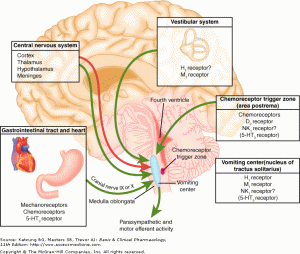HPI:
57yo male with a history of HTN, DM, and MI s/p stent in 2011 presenting with nausea/vomiting and hypotension. The patient had one episode of non-bloody, non-bilious emesis approximately 6 hours ago. He felt unwell so a friend checked his blood pressure which was found to be 75/50, prompting a visit to this emergency department.
The patient’s emesis came 2 hours following a normal meal (frozen dinner), and was associated with chills/sweats but no abdominal pain. The patient had some associated shortness of breath (baselines), but no chest pain, arm or jaw pain, or palpitations.
He states that these symptoms are unlike what he experienced during his MI. He reported no change in bowel or urinary habits.
PMH:
| PSH:
|
FH:
| SHx:
|
Meds:
| Allergies:
|
Physical Exam:
| VS: | T | 98.4 | HR | 65 | RR | 17 | BP | 96/56 | O2 | 95% 2L NC |
| Gen: | No acute distress, speaking in complete sentences | |||||||||
| HEENT: | PERRL, MMM no lesions, no cervical lymphadenopathy | |||||||||
| CV: | RRR, normal S1/S2, no murmurs, no extra heart sounds, no jugular venous distension | |||||||||
| Lungs: | CTAB, no crackles | |||||||||
| Abd: | +BS, soft, NT/ND, no rebound/guarding, no organomegaly | |||||||||
| Ext: | Warm, well-perfused, peripheral pulses equal b/l, no LE edema | |||||||||
| Neuro: | AAOx3 | |||||||||
Labs:
- EKG: normal sinus rhythm, anterior lead q-waves suggestive of old infarct, no T/ST changes
- Troponin: <0.01
- CBC: 7.4/15.5/47/228
- BMP: 139/5.1/107/26/8/1.19/112 (baseline creatinine 1.06 in 2/2013)
Studies:
- CXR: no effusion, no cardiomegaly, no focal consolidation
- Bedside US: normal cardiac wall motion, estimated EF 40-45%, retrohepatic IVC collapses with respiration
Assessment/Plan:
57M hx HTN, DM, MI s/p stent presenting with nausea/vomiting x1 and hypotension. The patient’s symptoms and history were concerning for acute myocardial infarction; however, early EKG and troponins were reassuring. Additionally, the absence of characteristic physical findings that would be associated with an acute MI causing cardiogenic shock (elevated JVP, extra heart sounds, pulmonary crackles) were not present. Evidence of end-organ damage was also absent.
Other potential causes for nausea/vomiting include SBO, however, the patient reported normal BM’s and has no history of abdominal surgery. Though occurring after a meal, a single episode of emesis without associated abdominal pain lowers suspicion for biliary disease. This patient’s emesis is most likely due to acute gastroenteritis.
Given the evidence of hypovolemia on bedside ultrasound, the patient was bolused with a total of 1.5L NS and noted symptomatic improvement as well recovery of blood pressure.
Differential Diagnosis of Nausea/Vomiting: 1, 2
Pathophysiology: 3, 4, 5
- Nausea: Sensation associated with increased gastrointestinal motility (tachygastria).
- Vomiting:
- Chemoreceptor trigger zone (area postrema of 4th ventricle): sensitive to drugs/toxins (emetics, radiation), neurotransmitters. Located outside BBB.
- Nucleus tractus solitaries (medulla): pattern generator for vomiting, receives vagal input from GI tract and nociceptive stimuli from peripheral nervous system – transmits to hypothalamus, limbic system and cortex. Stimulated by tickling the back of the throat, gastric distention, and vestibular input.
Important history/physical associations: 4
- Abdominal pain: suggests organic disease, affected organ dependent on location of pain. (See figure)
- Abdominal distension: suggests bowel obstruction.
- Heartburn: suggests GERD.
- Vertigo/nystagmus: suggests vestibular etiology.
- Positional/projectile: suggests neurogenic etiology.
Differential Diagnosis of Abdominal Pain By Location:
References:
- Scorza, K., Williams, A., Phillips, J. D., & Shaw, J. (2007). Evaluation of nausea and vomiting. American family physician, 76(1), 76–84.
- Bork S, Ditkoff J, Hang BS. Chapter 75. Nausea and Vomiting. In: Tintinalli JE, Stapczynski JS, Cline DM, Ma OJ, Cydulka RK, Meckler GD, eds. Tintinalli’s Emergency Medicine: A Comprehensive Study Guide. 7th ed. New York: McGraw-Hill; 2011. http://www.accessmedicine.com/content.aspx?aID=6360091. Accessed June 15, 2013.
- Koch, K. L., Stern, R. M., Vasey, M. W., Seaton, J. F., Demers, L. M., & Harrison, T. S. (1990). Neuroendocrine and gastric myoelectrical responses to illusory self-motion in humans. The American journal of physiology, 258(2 Pt 1), E304–10.
- Longstreth, G. F. Approach to the adult with nausea and vomiting. In: UpToDate, Basow, DS (Ed), UpToDate, Waltham, MA, 2013.
- Costanzo, L. (2011). Physiology. Philadelphia: Wolters Kluwer Health/Lippincott Williams & Wilkins.
- Patanwala, A. E., Amini, R., Hays, D. P., & Rosen, P. (2010). Antiemetic therapy for nausea and vomiting in the emergency department. The Journal of emergency medicine, 39(3), 330–336. doi:10.1016/j.jemermed.2009.08.060



